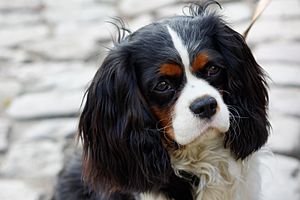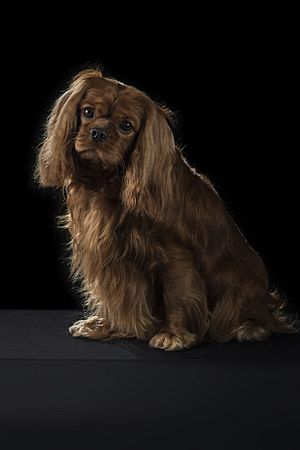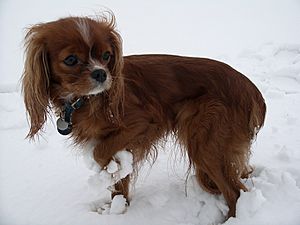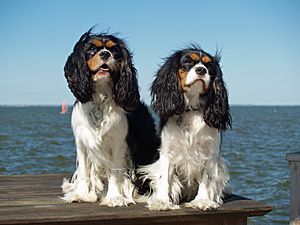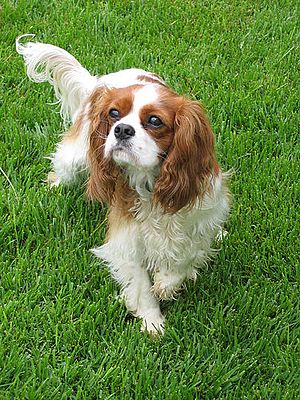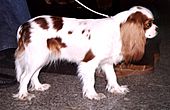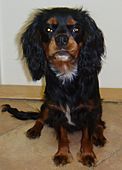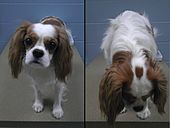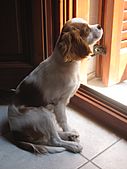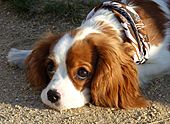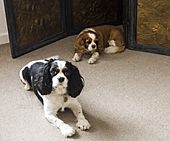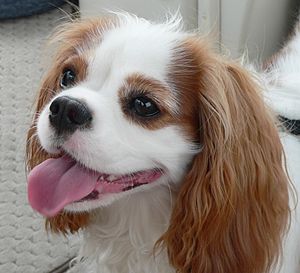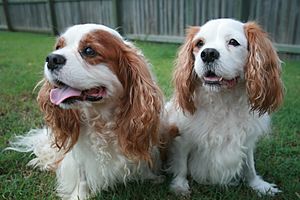Cavalier King Charles Spaniel facts for kids
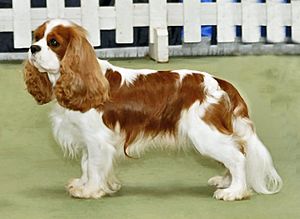
Blenheim Cavalier King Charles Spaniel
|
||||||||||||||||||||||||||
| Origin | United Kingdom | |||||||||||||||||||||||||
|---|---|---|---|---|---|---|---|---|---|---|---|---|---|---|---|---|---|---|---|---|---|---|---|---|---|---|
|
||||||||||||||||||||||||||
|
||||||||||||||||||||||||||
| Domestic dog (Canis lupus familiaris) | ||||||||||||||||||||||||||
The Cavalier King Charles Spaniel is a small, friendly dog breed. It is known as a toy dog because of its size. This breed first came from the United Kingdom. Since the year 2000, it has become very popular in the United States. It is now one of the top 20 most popular purebred dogs there.
Cavaliers have a soft, silky coat. Their tails are usually smooth and not shortened. There are four main colors for this breed. These are Blenheim (chestnut and white), Tricolour (black, white, and tan), Black and Tan, and Ruby. Cavaliers are usually very loving and get along well with kids and other pets. They love being around people. It's best not to leave them alone for too long. A Cavalier King Charles Spaniel usually lives for about ten years.
The look of the Cavalier King Charles Spaniel changed a lot in the late 1600s. This happened when they were bred with dogs that had flatter noses. For a long time, the Cavalier was seen as the same breed as the smaller King Charles Spaniel. In the 1920s, breeders tried to bring back the older look. They wanted a dog that looked like the spaniels owned by Charles II of England. Like many breeds, Cavaliers can have some health issues.
Contents
A Look Back: The History of Cavalier King Charles Spaniels
In the early 1700s, John Churchill, 1st Duke of Marlborough, owned red and white spaniels. He used them for hunting. These dogs were fast enough to keep up with a trotting horse. His home was named Blenheim Palace after his victory at the Battle of Blenheim. Because of this, the red and white spaniels became known as "Blenheim" spaniels. This name is still used for one of the Cavalier colors today.
People tried to bring back the original Cavalier King Charles Spaniel look early in the 1900s. They even used a breed called the Toy Trawler Spaniel, which is now extinct. These efforts were written about in a book in 1911.
How Cavaliers Became Their Own Breed
In 1926, an American named Roswell Eldridge offered a prize. He wanted to find "Blenheim Spaniels of the old type." These dogs had long faces and flat skulls, like those seen in paintings from the time of Charles II of England. Dog breeders at the time were surprised by this idea.
Even though Eldridge passed away, some breeders liked his idea. In 1928, the first Cavalier club was started. They created the first official description of the breed. The Kennel Club in the UK then recognized them as "King Charles Spaniels, Cavalier type."
World War II caused big problems for the new breed. Many breeding dogs were lost due to the war and food shortages. For example, one kennel went from sixty dogs down to just three. After the war, only a few dogs were left. All modern Cavaliers come from these few survivors. In 1945, the Kennel Club officially recognized the Cavalier King Charles Spaniel as its own breed.
The Cavalier's history in America is more recent. The first Cavalier came to the United States in 1956. In 1994, a group of breeders formed the American Cavalier King Charles Spaniel Club. This club worked to get the breed recognized by the American Kennel Club. In 1995, the American Kennel Club officially recognized the Cavalier.
What Does a Cavalier Look Like?
Cavalier King Charles Spaniels were historically bred to be lap dogs. They are small for a spaniel. Adult Cavaliers are about 12 to 13 inches (30 to 33 cm) tall. They usually weigh between 13 to 18 pounds (5.9 to 8.2 kg). Their tails are typically not shortened.
Cavaliers have a silky coat that is medium in length. It should be mostly straight, but a slight wave is okay. As they grow, they get longer hair, called "feathering," on their ears, feet, legs, and tail. This feathering should be kept long. The long hair on their feet is a special feature of the breed.
People sometimes confuse the Cavalier King Charles Spaniel with the English Toy Spaniel. In the UK, the English Toy Spaniel is called the King Charles Spaniel. These two breeds have similar histories. They only became separate breeds about 100 years ago. The main difference is their size. Cavaliers are usually 13 to 18 pounds (5.9 to 8.2 kg), while King Charles Spaniels are smaller, at 9 to 15 pounds (4.1 to 6.8 kg). Also, Cavaliers have higher-set ears and a flatter head. Their muzzles are also longer than those of the King Charles Spaniel.
Cavalier Colors
Cavaliers come in four recognized colors:
- Blenheim: These dogs have rich chestnut markings on a pearly white coat. This color is named after Blenheim Palace. Sometimes, there is a chestnut spot in the middle of the forehead. This is called the "Blenheim spot." A legend says this spot comes from Sarah Churchill, Duchess of Marlborough. She supposedly pressed her thumb on a pregnant dog's head while waiting for news of her husband's return from battle.
- Black and Tan: These Cavaliers have black bodies with tan markings. You can see tan on their eyebrows, cheeks, legs, and under their tail. In the King Charles Spaniel breed, this color is called "King Charles."
- Ruby: Ruby Cavaliers are entirely chestnut in color. They should not have any white markings. Sometimes, their ears or "slippers" (long hair on feet) might be a bit lighter.
- Tricolour: This color is black and white with tan markings. The tan spots are on their cheeks, inside their ears, on their eyebrows, inside their legs, and under their tail. This color is called "Prince Charles" in the King Charles Spaniel breed.
How Popular Are Cavaliers?
Cavaliers are quite popular around the world. In the United Kingdom, they were the sixth most popular dog breed in 2007. Over 11,000 Cavaliers were registered that year. In America, their popularity has grown a lot. In 1998, they were the 56th most popular breed. By 2013, they had moved up to 18th place.
In some US cities, Cavaliers are even more popular. For example, in 2008, they were among the top ten breeds in cities like Nashville, Minneapolis-St.Paul, Boston, Atlanta, Washington D.C., New York City, and San Francisco. In Australia, Cavaliers were the fourth most popular breed in 2009. Many other countries also have national clubs for the breed. These include Belgium, Canada, France, Germany, and New Zealand.
Cavalier Personality: What Are They Like?
Cavaliers are known for being very loving and playful. They are also extremely patient and eager to please their owners. This makes them great with children and other dogs. Cavaliers are not shy and will often play with much larger dogs. They can quickly adjust to almost any home or family. They are happy living in a city apartment or a country house. Their ability to get along with different sized dogs makes them perfect for homes with multiple pets.
Cavaliers are considered to have average intelligence for working or obedience. They are naturally curious and love to play. But they also enjoy cuddling up on a cushion or a lap. This makes them excellent companion dogs. They are often used as therapy dogs because of their sweet and gentle nature.
Cavaliers are active and enjoy sports. They do well in dog shows, obedience training, and agility courses. They can adapt their exercise needs. They are happy with either sleeping on the couch or going for long walks.
Cavaliers have a strong instinct to chase moving things. This includes cars on busy streets. So, most Cavaliers should not be allowed to roam freely near roads. They also tend to see all strangers as friends. This means they usually don't make good guard dogs. Spaniels have a strong hunting instinct. They might chase birds and small animals. However, many owners say their Cavaliers live happily with small pets like hamsters and gerbils after proper training.
A Cavalier's coat needs to be brushed weekly. It does not need trimming. However, some owners prefer to trim the long feathering on their Cavalier's feet and ears. This can help keep them clean, especially after playing outside.
Related Pages
Images for kids
See also
 In Spanish: Cavalier King Charles spaniel para niños
In Spanish: Cavalier King Charles spaniel para niños


